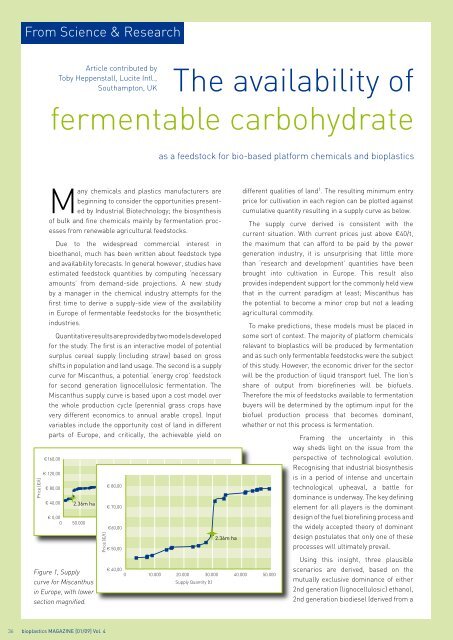bioplasticsMAGAZINE_0901
bioplasticsMAGAZINE_0901
bioplasticsMAGAZINE_0901
Create successful ePaper yourself
Turn your PDF publications into a flip-book with our unique Google optimized e-Paper software.
From Science & Research<br />
Article contributed by<br />
Toby Heppenstall, Lucite Intl.,<br />
Southampton, UK<br />
The availability of<br />
fermentable carbohydrate<br />
as a feedstock for bio-based platform chemicals and bioplastics<br />
Price [€/t]<br />
Many chemicals and plastics manufacturers are<br />
beginning to consider the opportunities presented<br />
by Industrial Biotechnology; the biosynthesis<br />
of bulk and fine chemicals mainly by fermentation processes<br />
from renewable agricultural feedstocks.<br />
Due to the widespread commercial interest in<br />
bioethanol, much has been written about feedstock type<br />
and availability forecasts. In general however, studies have<br />
estimated feedstock quantities by computing ‘necessary<br />
amounts’ from demand-side projections. A new study<br />
by a manager in the chemical industry attempts for the<br />
first time to derive a supply-side view of the availability<br />
in Europe of fermentable feedstocks for the biosynthetic<br />
industries.<br />
Quantitative results are provided by two models developed<br />
for the study. The first is an interactive model of potential<br />
surplus cereal supply (including straw) based on gross<br />
shifts in population and land usage. The second is a supply<br />
curve for Miscanthus, a potential ‘energy crop’ feedstock<br />
for second generation lignocellulosic fermentation. The<br />
Miscanthus supply curve is based upon a cost model over<br />
the whole production cycle (perennial grass crops have<br />
very different economics to annual arable crops). Input<br />
variables include the opportunity cost of land in different<br />
parts of Europe, and critically, the achievable yield on<br />
€160,00<br />
€ 120,00<br />
€ 80,00<br />
€ 40,00<br />
2.36m ha<br />
€ 0,00<br />
0 50.000<br />
Figure 1, Supply<br />
curve for Miscanthus<br />
in Europe, with lower<br />
section magnified.<br />
Price [€/t]<br />
€ 80,00<br />
€ 70,00<br />
€60,00 Supply Quantity / ktes<br />
€ 50,00<br />
30m ha<br />
2.36m ha<br />
2.36m ha<br />
€ 40,00<br />
0 10.000 20.000 30.000 40.000 50.000<br />
Supply Quantity [t]<br />
different qualities of land 1 . The resulting minimum entry<br />
price for cultivation in each region can be plotted against<br />
cumulative quantity resulting in a supply curve as below.<br />
The supply curve derived is consistent with the<br />
current situation. With current prices just above €40/t,<br />
the maximum that can afford to be paid by the power<br />
generation industry, it is unsurprising that little more<br />
than ‘research and development’ quantities have been<br />
brought into cultivation in Europe. This result also<br />
provides independent support for the commonly held view<br />
that in the current paradigm at least; Miscanthus has<br />
the potential to become a minor crop but not a leading<br />
agricultural commodity.<br />
To make predictions, these models must be placed in<br />
some sort of context. The majority of platform chemicals<br />
relevant to bioplastics will be produced by fermentation<br />
and as such only fermentable feedstocks were the subject<br />
of this study. However, the economic driver for the sector<br />
will be the production of liquid transport fuel. The lion’s<br />
share of output from biorefineries will be biofuels.<br />
Therefore the mix of feedstocks available to fermentation<br />
buyers will be determined by the optimum input for the<br />
biofuel production process that becomes dominant,<br />
whether or not this process is fermentation.<br />
Framing the uncertainty in this<br />
way sheds light on the issue from the<br />
perspective of technological evolution.<br />
Recognising that industrial biosynthesis<br />
is in a period of intense and uncertain<br />
technological upheaval, a battle for<br />
dominance is underway. The key defining<br />
element for all players is the dominant<br />
design of the fuel biorefining process and<br />
the widely accepted theory of dominant<br />
design postulates that only one of these<br />
processes will ultimately prevail.<br />
Using this insight, three plausible<br />
scenarios are derived, based on the<br />
mutually exclusive dominance of either<br />
2nd generation (lignocellulosic) ethanol,<br />
2nd generation biodiesel (derived from a<br />
36 bioplastics MAGAZINE [01/09] Vol. 4


















